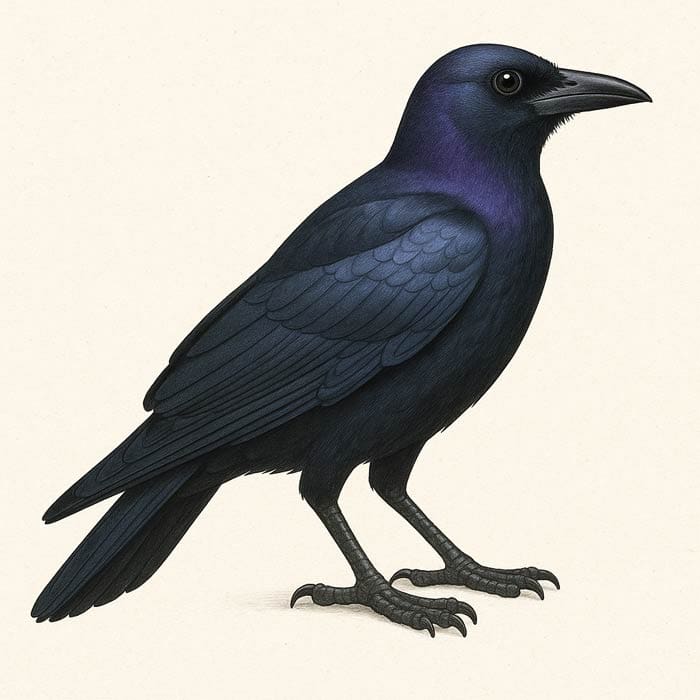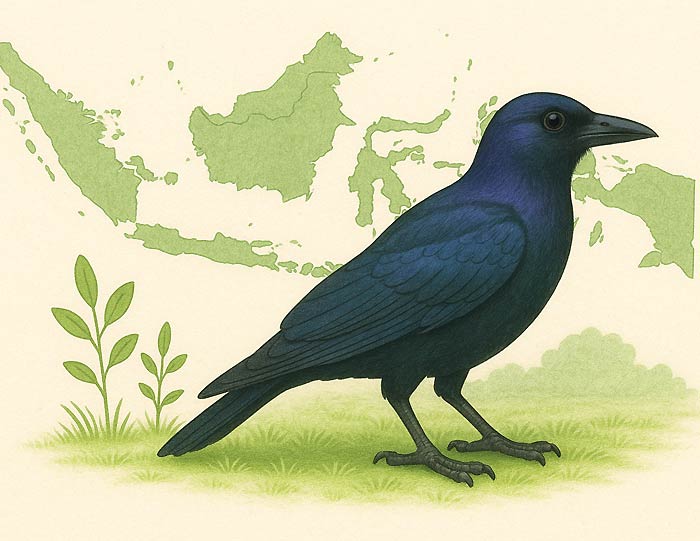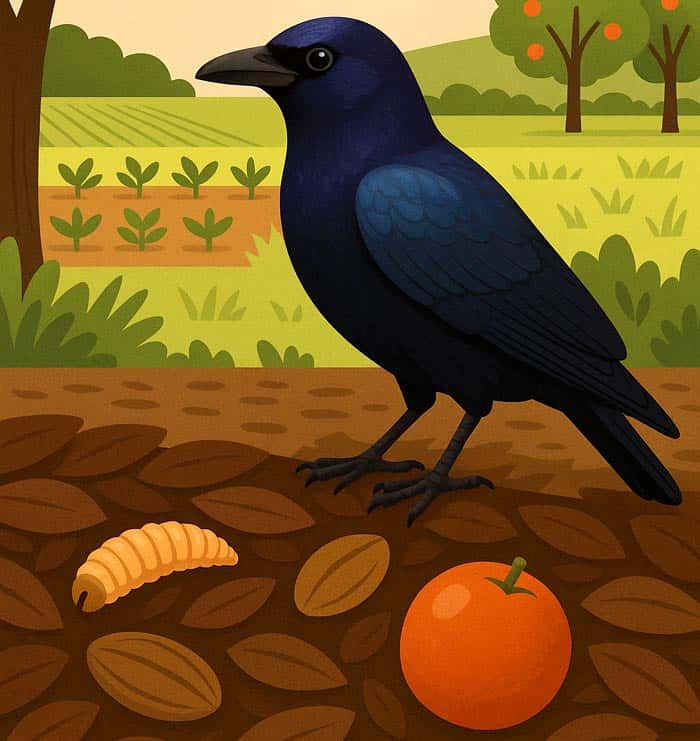
| Animalia | Passeriformes | Corvidae | Corvus | Corvus violaceus |
The violet crow (Corvus violaceus) is a distinctive member of the crow family, Corvidae, and is endemic to the island of Seram in Indonesia. Once considered a subspecies of the slender-billed crow, Genetic studies have confirmed its status as a separate species. The violet crow’s unique plumage and restricted range make it an intriguing subject for ornithologists and bird enthusiasts.
Table of Contents
- Common Name: Violet Crow.
- Family: Corvidae
- Body Dimensions: Medium-sized; short tail.
- Male Plumage Colors: Black with purplish sheen.
- Female Plumage Colors: Black with purplish sheen.
- Habitat: Forests, plantations, forest edge.
- Diet: Omnivorous
- Native Countries: Indonesia
- Continents: Asia
Violet Crow’s Physical Characteristics
The violet crow is notable for its striking appearance, which sets it apart from other types of crows.
- Particularly, adult birds exhibit a predominantly dark black head, complemented by a slightly blue-black sheen across the body.
- This subtle iridescence gives the bird its common name, as the plumage can appear violet under certain lighting conditions.
- The bill of the violet crow is somewhat shorter than most other crow species, including the Torresian Crow (Corvus orru), contributing to its unique profile.
- This contrasts with species like the Thick-billed Raven (Corvus crassirostris) and the White-necked Raven (Corvus albicollis), species whose massive bills are adapted for highland scavenging in Africa.
In terms of size, the violet crow is similar to other medium-sized crows. However, precise measurements are not widely known.
- The bird’s robust build and strong legs are well-adapted for a terrestrial lifestyle, allowing it to forage effectively on the forest floor. The wings are broad and rounded, suitable for maneuvering through dense forest canopies.
- The eyes are dark, and the overall structure of the head and beak reflects its adaptation to a varied diet, characteristic of many corvids.
- Juvenile violet crows resemble adults in coloration but may display slightly duller plumage until maturity.
The species’ physical adaptations, including its coloration and bill shape, are believed to be evolutionary responses to its specific habitat and ecological niche on Seram.
Violet Crow Habitat

The violet crow is native to Seram, an island in Indonesia, inhabiting various forested environments.
- Its primary habitat consists of lowland and hill forests, where it finds ample food and nesting sites.
- These black birds are also known to utilize plantations and, to a lesser extent, more open areas and farmland, particularly when foraging for food.
Despite being largely terrestrial, the violet crow is not migratory and remains within its native range year-round.
- Unlike the Brown-necked Raven (Corvus ruficollis), which thrives in arid and semi-desert regions of North Africa and the Middle East, the violet crow prefers humid tropical forests.
- However, its adaptability to both primary and secondary forests, as well as plantations, allows it to exploit both primary and secondary forests and human-modified landscapes such as plantations.
- This flexibility in habitat selection has likely contributed to its stable population status, even as some forested areas on Seram face anthropogenic pressures.
Suggested Reading:
Indonesian Monkeys & Apes
Diet and Hunting Behavior

Direct studies of the violet crow’s diet are lacking. Still, as a member of the Corvidae family, it is presumed to be omnivorous.
- It likely exhibits a high degree of behavioral flexibility regarding foraging, a trait shared by other types of birds, such as the Chihuahuan Raven (Corvus cryptoleucus). The violet crow consumes a broad range of foods, including invertebrates, fruits, seeds, and more.
- Its strong, short bill is well-suited for probing into leaf litter and crevicesWhat is crevices?Crevices are narrow cracks or openings, often found in rocks or walls., suggesting a preference for terrestrial foraging.
- The species is often seen foraging alone, in pairs, or in small groups, mainly in the forest canopy and at the edge.
In addition, the violet crow’s presence in plantations and open farmland indicates a degree of opportunism in its feeding behavior, allowing it to exploit natural and human-altered environments for food resources.
Ecological Importance
The violet crow is currently classified as “Least Concern” on the IUCN Red List, reflecting its stable population and relatively wide distribution within its restricted range.
- Although endemic to Seram, the species demonstrates adaptability to various forest types and human-modified habitats, which has likely contributed to its resilience in habitat alteration.
- The conservation significance of the violet crow lies in its role as an indicator species for the health of Seram’s forest ecosystems. As a native corvid, it may contribute to seed dispersal and pest control, supporting the ecological balance of its habitat.
- The continued survival of the violet crow is also important for maintaining the island’s unique biodiversity, as it represents a distinct evolutionary lineage within the Corvidae family.
- Conservation efforts should focus on preserving the integrity of Seram’s forests and monitoring potential threats, such as deforestation and habitat fragmentation, to ensure the long-term viability of this species.
Violet Crow Fun Facts
- Its scientific name, Corvus violaceus, refers to the subtle violet sheen on its plumage.
- The species was once considered a subspecies of the slender-billed crow but is now recognized as genetically distinct.
- The violet crow is known by various names in different languages, such as “Gagak hutan” in Indonesian and “Seramkrähe” in German.
- It is a non-migratory resident, remaining within its home range throughout the year.
Frequently Asked Questions
What is the scientific significance of the violet crow?
The violet crow is important for understanding the evolutionary history and biogeography of the Corvidae family in the Wallacea region, as it represents a distinct lineage.
Are there any conservation actions for the violet crow?
There are no targeted conservation actions for the violet crow. Still, its habitats are included within some protected areas on Seram, which may benefit the species indirectly.
What is the global range of the violet crow?
The violet crow is restricted solely to the island of Seram in Indonesia and is not found anywhere else.
Are there any cultural or spiritual associations with the violet crow?
Some people believe this species has symbolism as a spirit totem, representing transformation and intelligence.
How is the violet crow different from the Cape crow?
The violet crow and the Cape Crow (Corvus capensis) differ significantly in both range and appearance. The violet crow is endemic to Indonesia and is known for its purplish-black iridescent plumage and relatively short bill. In contrast, the cape crow is native to various parts of sub-Saharan Africa and has a longer, more slender bill and glossy black feathers without the violet sheen.
The violet crow is a unique and resilient member of Indonesia’s avifauna, distinguished by its striking plumage, restricted range, and adaptability to diverse habitats.
Despite being confined to Seram, the species maintains a stable population and is not currently threatened, thanks partly to its ability to thrive in natural and human-modified environments. The violet crow’s ecological role and evolutionary distinctiveness underscore the importance of continued conservation efforts on Seram, ensuring that this remarkable bird remains a vibrant part of the island’s biodiversity for generations to come












